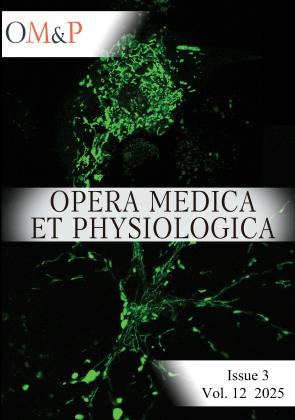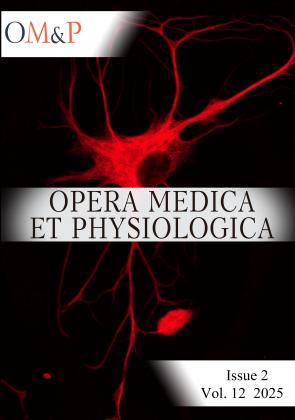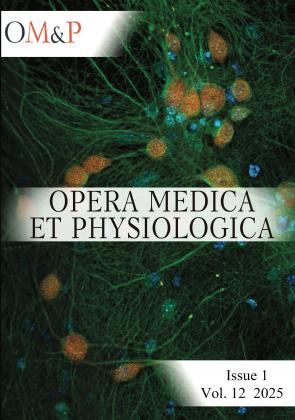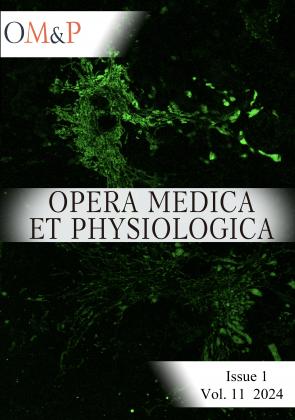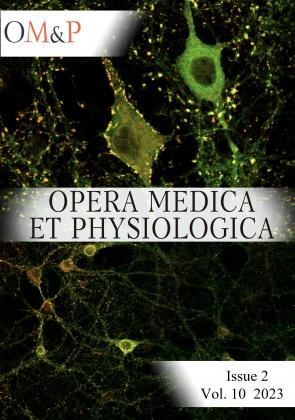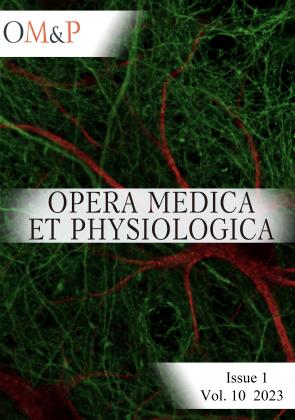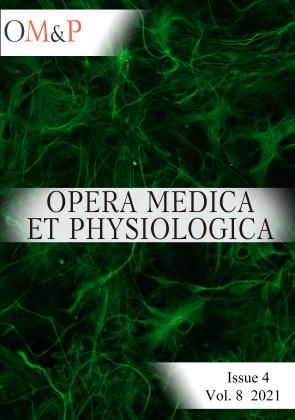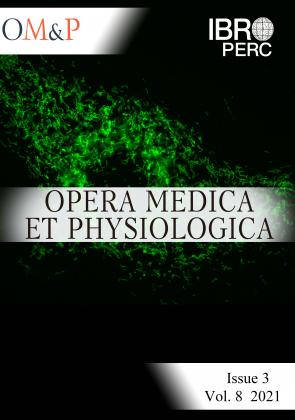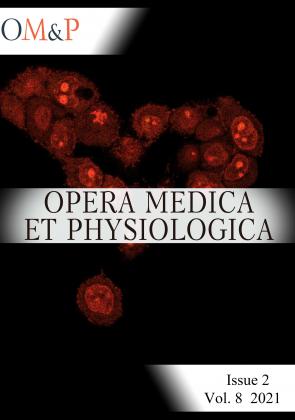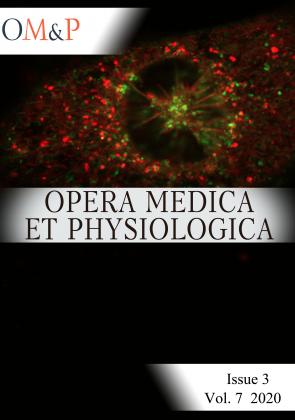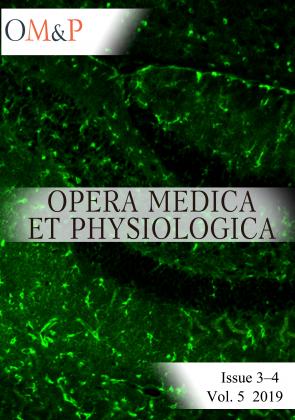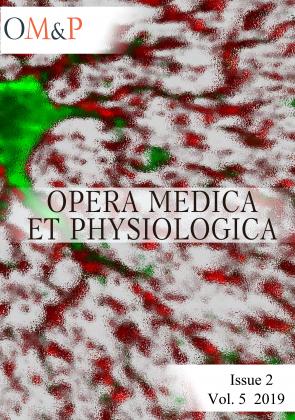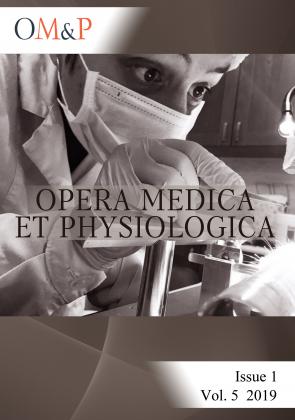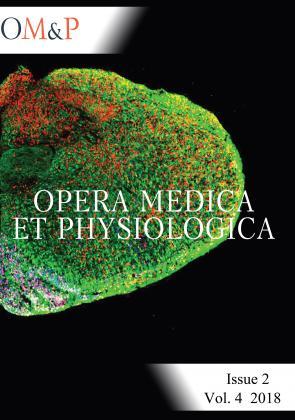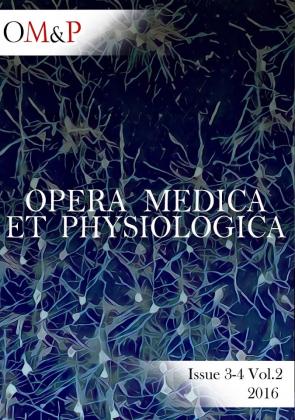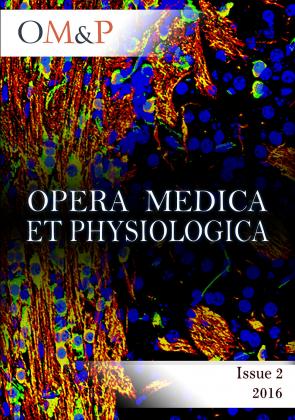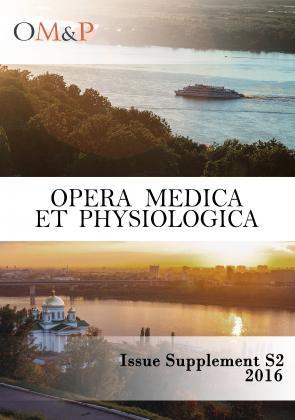Issue 3 | September 2025
Full-length research paper
Published ahead of print September 15, 2025; Printed September 15, 2025; OM&P 2025 Volume 12 Issue 3, pages 156-162; doi:10.24412/2500-2295-2025-3-156-162
Abstract
Full Text
Clear cell renal cell carcinoma (ccRCC) is a highly aggressive form of cancer that frequently recurs and metastasizes, necessitating the search for novel molecular markers to enhance diagnosis and prognosis. Single nucleotide polymorphisms (SNPs) in long non-coding RNA (lncRNA) genes, which have a pivotal role in tumorigenesis, represent promising candidates for such biomarkers. The TaqMan allele discrimination method of genotyping of six SNPs (rs11263432, rs4506680, rs793096, rs619586, rs3200401, and rs3741219) within lncRNA genes (LINC02952, LINC02747, LINC02664, MALAT-1 and H19) was performed on 128 patients with ccRCC from the Tatar population and 134 healthy control individuals, who were comparable in terms of gender, age, and region of residence. The statistical analysis assessed the association between genotypes and the risk of ccRCC development. Significant associations with the risk of developing ccRCC have been identified. The rs11263432*T, rs79396*T, and rs619586*A alleles were associated with an increased risk of the disease (OR = 2.32 (95%CI = 1.1-5.3) p = 0.04, OR = 1.49 (95%CI = 1.0-2.1) p = 0.03 and OR = 1.33 (95%CI = 0.3-6.7) p = 0.03, respectively). No statistically significant associations with ccRCC risk were found for rs4506680, rs3200401, and rs3741219 polymorphisms. The results of the study indicate that specific polymorphisms in the lncRNA LINC02952, LINC02664 and MALAT-1 genes may serve as potential markers of predisposition to ccRCC in the studied population. The findings highlight the important role of variations in lncRNA genes in ccRCC pathogenesis and their possible potential as targets for developing new approaches to personalized diagnosis and risk assessment.
Full-length research paper
Published ahead of print September 15, 2025; Printed September 15, 2025; OM&P 2025 Volume 12 Issue 3, pages 143-155; doi:10.24412/2500-2295-2025-3-143-155
Abstract
Full Text
Bladder cancer is one of the most common cancers worldwide. Recently, much attention has been focused on the study of long non-coding RNAs (lncRNAs) that are a class of noncoding RNA transcripts with length over 200 nucleotides localized in the nucleus and thought to play a regulatory role in carcinogenesis. In our study the expression levels of lncRNAs H19 and UCA1 were screened in normal and tumor bladder tissue of the patients with muscle invasive bladder cancer. The expression level of lncRNAs in tumor samples compared with normal tissue was increased by approximately 4 times: for H19 fold change (FC) = 4.03 (p-value = 0.0003), and for UCA1 FC = 4.83, (p-value = 0.0165). We performed a ROC-analysis for a combination of these lncRNAs, and the AUC was 0.747, model accuracy is 73.3%.
Full-length research paper
Published ahead of print September 15, 2025; Printed September 15, 2025; OM&P 2025 Volume 12 Issue 3, pages 135-142; doi:10.24412/2500-2295-2025-3-135-142
Abstract
Full Text
Gastric cancer (GC) is one of the leading causes of cancer death in the world (http://globocan.iarc.fr). In the Russian Federation, cancer of this localization ranks sixth among all malignant tumors in terms of incidence and second in mortality. Our study used a sample consisting of DNA samples isolated from the peripheral venous blood of patients with gastric cancer and healthy donors aged 21 to 88 years living in the Republic of Bashkortostan. The group of patients consisted of 156 people. As a control, a group of unrelated healthy donors without any gastrointestinal diseases was studied, consisting of 307 people of various ethnicities also living in the Republic of Bashkortostan. One of the promising areas is the study of mitochondrial dysfunction as a consequence of changes in energy metabolism, which are one of the signs of malignancy (Lee et al., 2014). In our study, we screened for known mutations of mtDNA molecules in patients with gastric cancer. The results of our studies show that all three loci we examined - a 4977 bp deletion located in the 8483-13459 mtDNA region, single nucleotide substitutions 15767 C>G in the CYB gene and 7080 T>C in the COI gene - most likely do not play a role as driver events in the occurrence of gastric cancer in individuals of Russian, Tatar and Bashkir ethnicity from the Republic of Bashkortostan.
Invited review
Published ahead of print September 15, 2025; Printed September 15, 2025; OM&P 2025 Volume 12 Issue 3, pages 115-134; doi:10.24412/2500-2295-2025-3-115-134
Abstract
Full Text
To date, tissue biopsy techniques for tumors are inferior to newer liquid biopsy (LB) technologies due to their convenience and informative nature. LB is a concept that has gained increasing attention due to its non-invasive nature and ability to analyze tumor status in real time. Samples for LB can include blood, urine, stool, saliva, pleural fluid, and cerebrospinal fluid. LB is one of the primary strategies for detecting tumor-associated biomarkers such as circulating tumor cells (CTCs), genetic markers (DNA, micro RNA (miRNA), messenger RNA (mRNA), tumor-educated platelets, and extracellular vesicles (EVs). These biomarkers enable real-time monitoring of tumor evolution and therapeutic response, which improves clinical decision-making at different stages of cancer treatment.
Full-length research paper
Published ahead of print September 15, 2025; Printed September 15, 2025; OM&P 2025 Volume 12 Issue 3, pages 108-114; doi:10.24412/2500-2295-2025-3-108-114
Abstract
Full Text
Aging is a natural and inevitable process that worsens the quality of life and shortens its duration. In the process of aging, the cardiovascular system undergoes significant restructuring, diastolic dysfunction is observed, vascular stiffness increases and vasodilation decreases. α2-ARs are widely distributed in the body and are involved in the regulation of heart and vascular functions. In pathological conditions, there is an increase in the expression of α2-AR subtypes, a violation of their functions, and a decrease in the effectiveness of the associated signalling cascades. The study aimed to investigate the effect of the α2-AR agonist clonidine hydrochloride at concentrations of 10-9-10-6 M on the inotropy, chronotropy and coronary flow of the old rats isolated heart. α2-AR stimulation changes all the studied parameters of the old rats isolated heart. The force of left the ventricular myocardium contraction decreases at concentrations of 10-9 and 10-8 M, and increases at concentrations of 10-7 and 10-6 M. The α2-AR agonist causes a decrease in heart rate in all studied concentrations. Stimulation of α2-AR in lower concentrations (10-9 - 10-7 M) reduces coronary flow, and the maximum concentration of clonidine hydrochloride (10-6 M) increases.
Full-length research paper
Published ahead of print September 15, 2025; Printed September 15, 2025; OM&P 2025 Volume 12 Issue 3, pages 93-107; doi:10.24412/2500-2295-2025-3-93-107
Abstract
Full Text
Aim: To study the association of variant rs4646994 of the ACE gene with the presence of post-COVID syndrome (PCS) in COVID-19 convalescents. Materials and methods: A sample of 270 COVID-19 convalescents, average age 53.2 ± 13.2 years: 62 without PСS (average age - 48.9 ± 13.6 years, proportion of men - 36 (58.1%)) and 208 with PСS (average age – 54.5 ± 12.8 years, proportion of men – 94 (45.2%)). The study took into account medical history, anthropometry, a number of biochemical blood parameters, echocardiography data. Genotyping of the rs4646994 variant of the ACE gene was performed using the allele-specific PCR method followed by electrophoresis of PCR products in a 3% polyacrylamide gel. Statistical processing of the obtained results was performed using the SPSS software package (version 13.0). Results: When comparing the groups of COVID-19 convalescents without PСS and COVID-19 convalescents with PСS, no statistically significant differences were found in the frequency of the rs4646994 genotypes of the ACE gene (p = 0.429). There was also no difference between the groups of COVID-19 convalescents without PСS and COVID-19 convalescents with PСS in the frequency of alleles I and D rs4646994 of the ACE gene (p = 0.419, p = 0.419, respectively). No association was found between the rs4646994 variant of the ACE gene and the cardiovascular and endocrine phenotypes (p = 0.410 and p = 0.741, respectively). Conclusion: According to the study, there was no association of the rs4646994 variant of the ACE gene with the presence of PCS, cardiovascular and endocrine phenotypes.
Full-length research paper
Published ahead of print September 15, 2025; Printed September 15, 2025; OM&P 2025 Volume 12 Issue 3, pages 87-92; doi:10.24412/2500-2295-2025-3-87-92
Abstract
Full Text
The study examined the possibility of using vesicular mRNA for diagnostic purposes using real-time PCR as a tool for analyzing the stage of development of changes in the body in response to prolonged alcohol intake. The study simulated the intermittent nature of prolonged alcohol consumption in Wistar rats, which reflects the pattern of alcohol consumption typical of individuals who abuse alcohol. Extracellular vesicles were isolated from the blood plasma of rats using differential ultracentrifugation. Their presence was confirmed by scanning electron microscopy. Total RNA extraction, cDNA synthesis, and real-time PCR were performed using commercial reagent kits. The study revealed elevated levels of several pro-inflammatory mRNAs in extracellular vesicles isolated from blood plasma. In the group of animals with prolonged alcoholization, the levels of Tnfα mRNA were increased, and the presence of Hmgb1 mRNA was confirmed. In the conditions of the cancellation of long-term alcoholization, on the 10th day, an increased level of pro-inflammatory mRNA Tnfα and Il1β were revealed and the content of mRNA Hmgb1 was again found. The obtained data show the diagnostic value of vesicular mRNA and open the prospect for subsequent research in this direction.
Full-length research paper
Published ahead of print September 15, 2025; Printed September 15, 2025; OM&P 2025 Volume 12 Issue 3, pages 82-86; doi:10.24412/2500-2295-2025-3-82-86
Abstract
Full Text
In this study, we assessed stress levels and selected hormonal parameters in young women (aged 28 to 35) who voluntarily limited their digital exposure over an extended period (three months or more). The study sample included both women with and without children, as the presence of children is commonly considered an additional stress factor. The results demonstrated that, regardless of parental status, reducing digital device usage led to a decrease in stress indicators and cortisol levels. Moreover, an increase in prolactin levels – a hormone associated, among other roles, with maternal behavior – was observed in the participants.
Full-length research paper
Published ahead of print September 15, 2025; Printed September 15, 2025; OM&P 2025 Volume 12 Issue 3, pages 67-81; doi:10.24412/2500-2295-2025-3-67-81
Abstract
Full Text
Breast cancer (BC) remains one of the leading causes of cancer-related mortality in women worldwide. Recent studies have explored the role of myokines, signaling proteins released during muscle contraction, in regulating tumor growth, metastasis, and the tumor microenvironment. This study investigates the correlation between myokines and breast cancer progression, focusing on the role of irisin and decorin. The study was conducted at two oncology centers in Baghdad, Iraq, from May to December 2022. A total of 88 Iraqi women, aged 20-70, were enrolled in the study across six groups: healthy controls (G1) and women with different treatment regimens (G2-G6). Blood samples were collected after fasting, and myokine concentrations were measured using ELISA. Additionally, histopathological examinations were performed on tissue biopsies to assess the presence of lobular carcinoma in situ (LCIS). The study found significant differences in myokine concentrations across the groups. Irisin levels were highest in the metastatic group (G6), while decorin levels showed significant variations across the different patient groups. Histological analysis revealed characteristic changes of LCIS, including irregular lobular structures, hyperplasia, and inflammatory cell infiltration. This study highlights the potential role of myokines, particularly irisin and decorin, as biomarkers for breast cancer progression. Elevated irisin levels in advanced stages suggest its involvement in tumor development and metastasis.
Full-length research paper
Published ahead of print September 15, 2025; Printed September 15, 2025; OM&P 2025 Volume 12 Issue 3, pages 49-66; doi:10.24412/2500-2295-2025-3-49-66
Abstract
Full Text
Green plant-based nanoparticles are becoming increasingly popular as a substitute for physical and chemical methods. A technique was used to synthesize selenium nanoparticles (SeNPs) using an ethanol extract of aerial parts of Adiantum capillus-veneris L. (ACV) as reducing agents for the H2SeO3 solution. The SeNPs were characterized using UV-vis, FTIR, AFM, SEM, XRD, EDX, and a zeta potential analyzer. The UV-Vis spectrum showed peaks at 269.0 nm and 311 nm. The FTIR spectrum of synthesized SeNPs confirms the existence of functional groups linked to bioactive molecules. The AFM results showed the lowest rate of nanosize reduction at 53.7 nm for nanosizes less than 100 nm. The SEM showed SeNPs with an appearance of small spherical with a diameter range of 27.91–12.28 nm. The XRD patterns of SeNPs synthesized by ACV extraction showed peaks at 28.48 and 58.76. The EDX spectrum showed elements such as Ca, Na, Mg, and K from the ACV leaf extract. The zeta potential of ACV SeNPs was 20.99 mV with a negative charge. The biological testing of SeNPs showed that they have antioxidant properties using the DPPH test, which was notably different from vitamin C. The in vitro cytotoxicity of SeNPs was investigated using the MTT assay. The results showed a non-toxic effect on the normal human fibroblast cell line (NHF) and anticancer activity against the breast cancer cell line (MCF-7).
Invited review
Published ahead of print September 15, 2025; Printed September 15, 2025; OM&P 2025 Volume 12 Issue 3, pages 28-48; doi:10.24412/2500-2295-2025-3-28-48
Abstract
Full Text
Familial hypercholesterolemia (FH) is a prevalent inherited lipid disorder marked by elevated low-density lipoprotein cholesterol (LDL-C) from early life, significantly increasing the risk of premature atherosclerotic cardiovascular disease (ASCVD). Recent advances in pharmacotherapy have transformed treatment possibilities, particularly for patients unresponsive to traditional therapies. This review synthesizes current evidence on emerging lipid-lowering agents, including PCSK9 monoclonal antibodies (e.g., evolocumab), small interfering RNA-based therapies (e.g., inclisiran), and angiopoietin-like protein 3 (ANGPTL3) inhibitors (e.g., evinacumab). Clinical trials demonstrate that these agents achieve substantial LDL-C reductions – often exceeding 40% – with favorable safety profiles, even in homozygous FH patients with null LDL receptor activity. Additionally, advances in genomic research have enabled more precise classification of pathogenic variants in genes such as APOB and ANGPTL3, improving diagnostic accuracy and guiding targeted therapy. The integration of these pharmacologic and genetic strategies represents a significant shift toward individualized management of FH. Further long-term and population-based studies are needed to validate these approaches and ensure equitable access across healthcare settings.
Full-length research paper
Published ahead of print September 15, 2025; Printed September 15, 2025; OM&P 2025 Volume 12 Issue 3, pages 13-27; doi:10.24412/2500-2295-2025-3-13-27
Abstract
Full Text
Full-length research paper
Published ahead of print September 15, 2025; Printed September 15, 2025; OM&P 2025 Volume 12 Issue 3, pages 5-12; doi:10.24412/2500-2295-2025-3-5-12
Abstract
Full Text
Breast cancer is a severe global health issue, having a high fatality rate worldwide. Because conventional cancer therapy is linked to tumour spread, drug resistance, and chemotherapy side effects, researchers should look into non-traditional methods. One intriguing strategy to deal with this issue is using nanoparticles and natural compounds like Lactobacillus metabolites as possible cancer treatments. Here, we tested the cytotoxicity of Lactobacillus cell-free supernatant (CFS), gold nanoparticles (AuNPs), and their combination against two cell lines MDA-MB-231 and Rat Embryonic Fibroblasts (REF) using MTT (3-(4,5-dimethylthiazol-2-yl)-2,5-diphenyltetrazolium bromide) assay and percentage of cell viability was recorded. Results showed a synergistic impact of the combination on MDA-MB-231 cells when the IC50 recorded was 70 µg/ml compared to treatments of CFS and AuNps alone when the IC50 recorded were 187 and 196 µg/ml respectively. On rat embryonic fibroblasts (REF) CFS displayed the most cytotoxic impact with IC50 equal to 115 µg/ml followed by combination treatment (IC50 = 693 µg/ml) and then by AuNPs with recorded IC50 of 895 µg/ml. In summary, we demonstrated that Lactobacillus cell-free supernatant, gold nanoparticles and their combination represent a promising candidate as anticancer agents. The cytotoxicity against breast cancer cell line was enhanced when the supernatant was combined with gold nanoparticles while the supernatant gave the best cytotoxic effect against REF cells.
Issue 2 | May 2025
Full-length research paper
Published ahead of print May 30, 2025; Printed May 30, 2025; OM&P 2025 Volume 12 Issue 2, pages 147-156; doi:10.24412/2500-2295-2025-2-147-156
Abstract
Full Text
The article presents the peculiarities of adaptive reactions of heart work to functional tests in young badminton players and children not engaged in sports at the age of 8-12 years. Continuous recording of electrocardiogram registration of children during the whole research protocol was carried out. It was shown that there are reliable changes of electrocardiographic parameters of heart work on active orthostatic test, as well as on the test with breath-holding. The analysis of electrocardiogram showed the presence of adaptive mechanisms of cardiovascular system of badminton players at the initial stage of sports training, it reflects a higher level of body fitness and contractility of the heart.
Full-length research paper
Published ahead of print May 30, 2025; Printed May 30, 2025; OM&P 2025 Volume 12 Issue 2, pages 133-146; doi:10.24412/2500-2295-2025-2-133-146
Abstract
Full Text
Purulent-septic skin infections occupy a leading position in the morbidity structure of newborns in obstetric hospitals, with Staphylococcus aureus identified as the primary etiological agent. Whole-genome sequencing (WGS) enables the acquisition of highly detailed genomic data on the spectra of pathogenicity genes, the mobilome, and the resistome of epidemic strains, as well as facilitating intraspecific typing of isolates. Aim of the study: To apply WGS technology to gain new insights into the genetic characteristics of S. aureus strains isolated during a period of epidemic occurrence in an obstetric hospital. This study employed WGS along with a range of bioinformatic tools, including dendrogram construction, calculation of average nucleotide identity (ANI) indices, and genetic mapping. The analysis established that the etiological agent of the epidemic outbreak of pemphigus neonatorum was a population of hospital-associated S. aureus ST121 t435 strains, isolated from both a healthcare worker and affected newborns. Strains of this genotype had not previously been associated with staphyloderma and were characterized by the presence of the eta gene (exfoliative toxin A) and two prophage-associated determinants of Panton-Valentine leukocidin, suggesting a high potential for horizontal gene transfer and dissemination among other S. aureus strains circulating within the hospital environment. Seven strains demonstrated resistance to oxacillin, attributed to modifications in native penicillin-binding proteins – an alternative mechanism to the well-known mec-mediated methicillin resistance pathway. These findings underscore the necessity of incorporating WGS technologies into molecular epidemiological surveillance in obstetric healthcare settings.
Full-length research paper
Published ahead of print May 30, 2025; Printed May 30, 2025; OM&P 2025 Volume 12 Issue 2, pages 123-132; doi:10.24412/2500-2295-2025-2-123-132
Abstract
Full Text
The aim is to determine the role of polymorphic loci of IL-1β, IL-10, TNF-α genes in families of patients with Helicobacter pylori-associated diseases. Materials and methods: Molecular genetic identification of H. pylori was carried out by PCR. Determination of cytokine gene polymorphisms (IL-1β (-31T/C), TNF-α (-308 G/A), IL-10 (-592C/A) and (+1082G/A) in 108 individuals – family members of individuals with chronic H. pylori-associated gastritis, was carried out by allele-specific PCR in real time. Results: H. pylori DNA was detected in 55.6% of patients' relatives, which is higher than the average prevalence in Russia (35.3%) and the Volga Federal District (33.0%). The distribution of gene polymorphisms of the studied cytokines in relatives of patients with and without H. pylori infection differed significantly. In H. pylori-infected family members, the T/T genotype and T allele of IL-1β (-31T/C), the C/C genotype of IL-10 (-592 C/A), and the G/G genotype of TNFα (-308 G/A) were significantly more frequently detected. No significant differences in IL-10 polymorphisms (+1082 G/A) were found in H. pylori positive and H. pylori negative individuals. Conclusions: IL 1β (-31T/C) T/T, IL 10 (-592 C/A) C/C, TNFα (-308 G/A) G/G gene polymorphisms increase the risk of H. pylori infection by more than 2 times. Carriers of such genotypes constitute a risk group for H. pylori-associated diseases, and in case of subclinical infection they are a source of infection and reinfection of relatives. Identification and treatment of infected family members is an important task in preventing the spread and recurrence of H. pylori infection.
Full-length research paper
Published ahead of print May 30, 2025; Printed May 30, 2025; OM&P 2025 Volume 12 Issue 2, pages 114-122; doi:10.24412/2500-2295-2025-2-114-122
Abstract
Full Text
The effect of a surgical laser on the physicochemical properties of molecules of two model proteins was studied: human immunoglobulin IgG and bovine serum albumin. After exposure to laser radiation, the optical density of protein solutions changes, the fluorescence intensity decreases, and the refractive index of the solutions does not change significantly. No massive damage or ruptures of the protein polypeptide chain were observed; on the contrary, intense aggregation of protein molecules was recorded. Thus, when exposed to a laser scalpel, partial denaturation and aggregation processes prevail in IgG and bovine serum albumin solutions, and aromatic amino acid residues are damaged to a lesser extent.
Invited review
Published ahead of print May 30, 2025; Printed May 30, 2025; OM&P 2025 Volume 12 Issue 2, pages 89-113; doi:10.24412/2500-2295-2025-2-89-113
Abstract
Full Text
Colorectal cancer (CRC) is characterized by a high mutational load and resistance to chemotherapy. Therefore, new approaches in the treatment of CRC include viral mimicry aimed at activating the expression of retroelements to stimulate the immune response against cancer. However, the role of activated retroelements in CRC carcinogenesis must be considered. Retroelements are implicated in CRC-specific chromothripsis and one of the highest percentages of retroelement insertions in CRC of any cancer type has been identified. In addition, retroelements are evolutionarily and functionally related to long noncoding RNAs, microRNAs, and circular RNAs. Therefore, a differentiated approach is needed in targeted therapy of CRC using circular RNAs as tools (as the most stable non-coding RNAs) to control the activity of retroelements. This article describes the analysis of scientific literature on the relationship in the mechanisms of CRC development of retroelements with circular RNAs, microRNAs and long non-coding RNAs. Data on the functioning of specific circular RNAs as tumor suppressors and oncogenes with their influence on microRNA and the expression of protein-coding genes are systematized. The nature of changes in the expression of transposon-derived microRNAs interacting with circRNAs and long noncoding RNAs in CRC is presented. The obtained data may form the basis for more correct epigenetic therapy of CRC with activation of only those retroelements that are not involved in CRC carcinogenesis.
Full-length research paper
Published ahead of print May 30, 2025; Printed May 30, 2025; OM&P 2025 Volume 12 Issue 2, pages 74-88; doi:10.24412/2500-2295-2025-2-74-88
Abstract
Full Text
Hypoxia is a common pathological condition that contributes to the development of various neurological disorders. Hypoxia-inducible factor (HIF) represents a promising therapeutic target for enhancing resistance to hypoxia and correcting neuronal dysfunction in the post-hypoxic period. In this study, the effects of two classes of HIF-prolyl hydroxylase (HIF-PHD) inhibitors on the resistance of C57BL/6 mice to hypoxic injury were investigated. The findings demonstrated that the HIF-PHD inhibitors Roxadustat and Adaptaquin exert a neuroprotective effect in hypoxic conditions by increasing the animals' resistance to acute hypobaric hypoxia. Among the tested compounds, Adaptaquin at a dose of 10 mg/kg exhibited the highest efficacy, reducing neuronal damage and edema in the prefrontal cortex during the post-hypoxic period and promoting the recovery of cognitive and motor functions. These results suggest the potential of HIF-PHD inhibitors for the treatment of hypoxic brain injury and neurodegenerative diseases.
Full-length research paper
Published ahead of print May 30, 2025; Printed May 30, 2025; OM&P 2025 Volume 12 Issue 2, pages 68-73; doi:10.24412/2500-2295-2025-2-68-73
Abstract
Full Text
Cardiovascular diseases are among the most prevalent pathologies worldwide, and myocardial infarction (MI) is a common cause of ventricular arrhythmias and sudden cardiac death. The development of MI is accompanied by profound alterations in the electrophysiological properties of cardiomyocytes, including a decrease in the amplitude and propagation velocity of the action potential. These changes lead to disturbances in excitability and impulse conduction not only in the affected region but also throughout the entire heart. Understanding the mechanisms underlying these alterations is crucial for developing novel approaches to the prevention and treatment of cardiovascular complications. The study aimed to investigate the dynamics of electrical activity changes in the right atrial myocardium at different stages of left ventricular myocardial infarction (MI) development in rats. Experimental MI was induced by ligation of the left coronary artery. We evaluated the effects of acute, subacute, and long-term consequences MI phases on the amplitude-time characteristics of action potentials in working right atrial cardiomyocytes.
Full-length research paper
Published ahead of print May 30, 2025; Printed May 30, 2025; OM&P 2025 Volume 12 Issue 2, pages 58-67; doi:10.24412/2500-2295-2025-2-58-67
Abstract
Full Text
Methacrylic resins (MAR) are highly sought-after materials for contemporary additive manufacturing of products, exhibiting a broad spectrum of applications. In order to impart new biological properties to the products printed using MSLA-technology, metal titanium nanoparticles (0.001-0.1 w.%) were added to the MAR composition. Samples of composite materials (MAR/Ti-NPs) were printed from the obtained modified resins. The present study demonstrated the ability of the obtained composite materials to enhance the formation of hydroxyl radicals and hydrogen peroxide molecules, to cause oxidative damage to DNA and protein molecules, and to significantly inhibit the growth of E. coli bacterial cultures and cause the death of bacterial cells during prolonged contact with the investigated material samples. The investigations conducted to assess the impact of the obtained composite materials on the proliferation and maturation of HSF cells have indicated an elevated degree of cytocompatibility.
Full-length research paper
Published ahead of print May 30, 2025; Printed May 30, 2025; OM&P 2025 Volume 12 Issue 2, pages 43-57; doi:10.24412/2500-2295-2025-2-43-57
Abstract
Full Text
This study investigated the production, purification, and vitro cytotoxic potential of L-glutaminase derived from Bacillus subtilis. Twenty-five bacterial isolates were recovered from diverse soil samples. Identification of B. subtilis was confirmed using standard biochemical assays, differential media, and the VITEK 2 automated system. Screening for L-glutaminase production identified B. subtilis isolate B7 as exhibiting the highest activity, with a crude enzyme-specific activity of 15.8 U/mg. Optimization of enzyme production parameters revealed glucose and yeast extract as optimal carbon and nitrogen sources, respectively, under controlled conditions of 40 °C and pH 6. L-glutaminase was purified using a four-step protocol: ammonium sulfate precipitation, ion exchange chromatography, gel filtration chromatography, and salt precipitation. Gel filtration chromatography resulted in the highest specific activity (754.6 U/mg), representing a 15.2-fold purification and a 21.1% yield relative to the crude extract. The in vitro cytotoxic effects of crude and purified L-glutaminase were evaluated using the MTT assay against the A549 (human lung adenocarcinoma) and WRL 68 (normal human liver) cell lines. Paclitaxel, a known chemotherapeutic agent, was a positive control for cytotoxicity against A549 cells. Treatment of A549 cells with purified L-glutaminase induced a dose-dependent reduction in cell viability, with a concentration of 400 µg/ml achieving maximal inhibition. These findings suggest that purified L-glutaminase from B. subtilis B7 demonstrates significant in vitro cytotoxic activity against A549 lung cancer cells and merits further investigation as a potential therapeutic candidate.
Full-length research paper
Published ahead of print May 30, 2025; Printed May 30, 2025; OM&P 2025 Volume 12 Issue 2, pages 27-42; doi:10.24412/2500-2295-2025-2-27-42
Abstract
Full Text
Pollutants, especially hydrocarbon oil pollutants, are among the most important problems spread worldwide due to the environmental and health problems to all forms of life, especially humans. Therefore, it is important today to find environmentally friendly and low-cost treatment methods to decrease the high risk of pollutants. In this study, the single-celled green algae including Chlorococcum humicola was used to treat different concentrations of anthracene. The results of the High-Performance Liquid Chromatography (HPLC) technique revealed that the alga used had high treatment efficiency, as naphthalene disappeared at concentrations of 100 and 200 ppm after day 12 of treatment. In addition, the results also showed the possibility of using the algae as a carbon source for anthracene.
Full-length research paper
Published ahead of print May 30, 2025; Printed May 30, 2025; OM&P 2025 Volume 12 Issue 2, pages 13-26; doi:10.24412/2500-2295-2025-2-13-26
Abstract
Full Text
Redox dynamics in mononuclear cells during phagocytosis and post-exposure to UV radiation was evaluated in vitro. Mononuclear cells were isolated from rat blood using density gradient centrifugation. Phagocytosis was activated via latex beads, and redox processes were monitored at 1, 30, and 60 minutes in control samples and after UV exposure at doses of 1, 5, and 15 J/m2. Cell viability post-phagocytosis was assessed using propidium iodide staining and cytofluorimetry. Redox processes in phagocytes were evaluated by measuring fluorescence of tryptophan, Schiff bases and glycated proteins, alongside absorption spectra/florescence levels of metabolic coenzymes FAD, NAD(P) and NAD(P)H and their ratios. In controls, cell viability decreased by 15.2% after 60 minutes of phagocytosis, while tryptophan, NAD(P), and NAD(P)H levels remained stable. Concentrations of Schiff bases and glycated proteins doubled. UV radiation significantly reduced cell viability in a dose-dependent manner. At 15 J/m2, 80.99% of cells were nonviable after 60 minutes of phagocytosis. This dose also caused a 21.42-fold decrease in tryptophan fluorescence, a 3.8-fold reduction in Schiff bases/ glycated proteins, and declined metabolic coenzyme levels. Ratios of NAD(P)H/FAD and NAD(P)H/NAD(P) decreased post-UV exposure, indicating oxidative dominance and NAD(P)H deficiency. However, despite UV-induced cytotoxicity, all experimental series, regardless of the dose of UV discharge, maintained control trends: non-enzymatic glycation products (Schiff bases, glycated proteins) increased, and the NAD(P)H/FAD ratio rose due to reduced coenzyme accumulation during phagocytosis. This suggests that phagocytic redox pathways persist under UV stress, albeit at diminished intensity.
Full-length research paper
Published ahead of print May 30, 2025; Printed May 30, 2025; OM&P 2025 Volume 12 Issue 2, pages 5-12; doi:10.24412/2500-2295-2025-2-5-12
Abstract
Full Text
Background: Saliva is an important body fluid that aids in digestion and contains a repertoire of important biomarkers. This research aimed to investigate the role of sodium bicarbonate toothpaste in regulating salivary indexes. Materials and Methods: The study involved taking saliva samples from healthy and fasting adult, male volunteers, aged between 20 to 45 years old. The samples were taken randomly and stratified, from 50 smokers and 50 non-smokers. The levels of metalloproteinase-8, interleukin-1β, pH, salivary flow rate, and α-amylase were measured, and the effects of sodium bicarbonate toothpaste application were investigated. Results: The levels of metalloproteinase-8 and interleukin-1β in smokers were significantly elevated, with more acidic saliva but reduced salivary flow rate and α-amylase. With the application of sodium bicarbonate, there were significant reductions in metalloproteinase-8 and interleukin-1β, with substantial improvement in pH, salivary flow rate, and α-amylase in both smokers and non-smokers. Conclusion: This study confirmed the negative effects of smoking. The use of sodium bicarbonate toothpaste enhanced oral health by reducing the pro-inflammatory biomarkers while improving the pH, salivary flow rate, and α-amylase.
Issue 1 | March 2025
Full-length research paper
Published ahead of print March 03, 2025; Printed March 03, 2025; OM&P 2025 Volume 12 Issue 1, pages 155-162; doi:10.24412/2500-2295-2025-1-155-162
Abstract
Full Text
Previously, it was assumed that somatic cells in male and female individuals had the same molecular pathways of ontogenesis. However, it has been shown that the course of various pathologies is associated with, among other things, genetic sexual dimorphism. It is known that glial cells are associated with the pathogenesis of various diseases, while the effect of sex chromosomes in glial cells has not been studied to date
Invited review
Published ahead of print March 03, 2025; Printed March 03, 2025; OM&P 2025 Volume 12 Issue 1, pages 136-154; doi:10.24412/2500-2295-2025-1-136-154
Abstract
Full Text
Microarrays are one of the modern technologies for analyzing biological polymers (DNA, RNA, antibodies, etc.). The main advantage of microarrays is the ability to simultaneously analyze a large number of different molecules in one sample. Microarrays are actively used to develop diagnostic tools, including in the analysis of community-acquired pneumonia pathogens. The relevance of studying community-acquired pneumonia is determined by the consistently high incidence, diversity of pathogens and their high genetic variability, as well as the recent spread of a new coronavirus infection. This review describes microarray technologies used to solve fundamental and clinical problems in the study of pathogens of community-acquired pneumonia and some other respiratory infections.
Full-length research paper
Published ahead of print March 03, 2025; Printed March 03, 2025; OM&P 2025 Volume 12 Issue 1, pages 127-135; doi:10.24412/2500-2295-2025-1-127-135
Abstract
Full Text
Previously, we reported that the hypomagnetic field obtained by the 100-fold deprivation of the geomagnetic field affected human cognitive processes as estimated in four different cognitive tests. The 40-minute exposure to the hypomagnetic field caused a statistically significant increase both in the task processing time and in the number of errors. The magnetic effect averaged over 40 healthy subjects was about 1.7%. In the present work, the results of a simultaneous study are described, in which the right eye of each subject was video recorded, while the subject performed the tasks. The pupil size increased in the hypomagnetic field. This effect has been calculated by processing the large data set of a few million video frames. The average magnetic effect was about 1.6% (<<0.01, ANOVA, factor of subjects - fixed). Given the heterogeneity, the effect was close to being significant (0.07, ANOVA, factor of subjects - random). The simultaneous recordings of magnetic reactions both for the different cognitive tests and for the eye pupil size were not correlated. These findings provide experimental confirmation of the random nature of the non-specific magnetic biological effects in humans.
Full-length research paper
Published ahead of print March 03, 2025; Printed March 03, 2025; OM&P 2025 Volume 12 Issue 1, pages 117-126; doi:10.24412/2500-2295-2025-1-117-126
Abstract
Full Text
Ovarian cancer remains one of the most common causes of death from gynecological cancer in women world-wide. As is known, the course of ovarian cancer depends on many factors, including genetic and epigenetic disorders. MicroRNAs are currently considered one of the most promising prognostic and diagnostic markers for solid tumors. The purpose of this work was to investigate the DNA methylation level of miR-663a and miR-663b in 25 paired tissue samples from patients with an established diagnosis of ovarian cancer and various histological and clinical characteristics by MS-HRM method. Our results indicate a lower frequency of miR-663a methylation in ovarian tumor tissues (0.09% ± 0.01) compared to histologically normal tissues 0.16% ± 0.01 (p = 0.01). However, an analysis of the miR-663a and miR-663b microRNA gene methylation level in patients with different clinical parameters, including the stage of disease development, the degree of cell differentiation, the occurrence of distant and regional metastases, as well as therapeutic pathomorphosis, not identify statistically significant differences in the methylation levels of these mi-croRNA genes with any of the clinical characteristics, p > 0.05. Thus, our results indicate a potential role of aberrant methylation of the miR-663a microRNA gene in ovarian cancer carcinogenesis. However, additional researches on larger sample sizes are needed to confirm the results obtained.
Full-length research paper
Published ahead of print March 03, 2025; Printed March 03, 2025; OM&P 2025 Volume 12 Issue 1, pages 106-116; doi:10.24412/2500-2295-2025-1-106-116
Abstract
Full Text
Introduction: acute limb ischemia is characterized by a sudden and severe reduction in blood supply to the limb, posing a critical threat to its viability. The incidence of complications associated with ALI remains significantly high. Currently, there is no consensus regarding which preoperative factors influence the incidence of complications in different revascularization methods, nor to what extent they contribute to postoperative outcomes. An analysis of the key predictors of complications will facilitate the development of preventive strategies and establish criteria for selecting the most appropriate treatment approach for ALI. Materials and methods: this study analyzes the outcomes of two treatment methods for ALI classified as Rutherford class II: open surgical intervention (Group I, n = 50) and endovascular procedures (Group II, n = 50). Results and discussion: the composition and impact of preoperative risk factors differed between the two revascularization methods. In the open surgery group, patients with an inflammatory, hypovolemic, or thrombophilic etiology of ALI (11) demonstrated a higher likelihood of an unfavorable postoperative course. Additionally, advanced patient age (7.1), Rutherford ischemia class IIB (0.2), a history of CAD (6.1), DM (9.2), CKD (12.1), and RF (8.5) were identified as significant risk factors for postoperative complications. In the endovascular revascularization group, among perioperative risk factors, the following variables demonstrated significant associations with postoperative complications: CAD (4.9), CKD (12.4), DM (5.28), RF (11), and Rutherford ischemia class IIB (0.2). Conclusion: selecting an appropriate revascularization method based on an individualized risk factor profile for each patient can effectively reduce the incidence of complications in the early postoperative period.
Full-length research paper
Published ahead of print March 03, 2025; Printed March 03, 2025; OM&P 2025 Volume 12 Issue 1, pages 91-105; doi:10.24412/2500-2295-2025-1-91-105
Abstract
Full Text
Relevance: neurofibromatosis type 1 (NF1) is a hereditary tumor syndrome occurring with a frequency of 1:3164. NF1 is characterized by severe clinical manifestations with multiple cutaneous and subcutaneous tumors, plexiform neurofibromas, skeletal abnormalities and cognitive disorders. The study of the genetic causes of NF1 can become the basis for prenatal diagnosis and the use of new methods of treating the disease. Materials and methods: clinical and epidemiological study of NF1 patients in the Republic of Bashkortostan, sequencing the NF1 gene in their DNA samples as well as whole genome sequencing using the WGS method. To search for the pathogenic variants we found in publications by other authors, we analyzed the Scopus, WoS, ClinVar, PubMed, and SNP databases. Results: the frequency of occurrence of NF1 in the republic is 1:7407. 23 nonsense pathogenic variants in 21 exons of the NF1 gene were identified in 39 NF1 patients from 26 families. Discussion and conclusion: the frequency of development of the main clinical manifestations of NF1 in patients from the republic corresponds to data from around the world, however, plexiform neurofibromas, optic nerve gliomas, short stature and decreased intelligence were detected significantly less frequently. Of the 23 nonsense pathogenic variants we identified, 16 pathogenic variants were previously described by researchers from various countries, and 7 pathogenic variants: NM_001042492.3:c.55G>T (NP_001035957.1:p.Glu19Ter), NM_001042492.3:c.2806A>T (NP_001035957.1:p.Lys936Ter), NM_001042492.3:c.3284T>A ( NP_001035957.1:p.Leu1095Ter), NM_001042492.3:c.5014G>T ( NP_001035957.1:p.Gly1672Ter), NM_001042492.3:c.5242C>T (NP_001035957.1:p.Arg1748Ter), NM_001042492.3:c.7365T>G (NP_001035957.1:p.Tyr2455Ter) and NM_001042492.3:c.7482G>A (NP_001035957.1:p.Trp2494Ter) have been identified for the first time in the word. Patients with nonsense pathogenic variants have significantly higher rates of brain tumors and epilepsy compared to all NF1 patients in the republic.
Full-length research paper
Published ahead of print March 03, 2025; Printed March 03, 2025; OM&P 2025 Volume 12 Issue 1, pages 83-90; doi:10.24412/2500-2295-2025-1-83-90
Abstract
Full Text
This paper presents the possibilities of using the Unity engine to create the research software for cognitive neuroscience using the brain-to-brain synchrony paradigm. Neurofeedback software for neuroscience research in the brain-to-brain synchrony paradigm is represented by software that allows to implement three research protocols based on the EEG signals recording: the “eyes-to-picture” in the double glasses HTC VIVE PRO protocol, the “eyes-to-eyes”/“ face-to-face” protocol and the “eyes-to-screens” protocol. The presented brain-to-brain synchrony software solution for the implementation of different protocols is a digital platform allowing to perform hyperscanning of electrical activity of the cerebral cortex simultaneously in several persons and thus study the functions of higher neural networks of socially determined areas of the cerebral cortex.
Full-length research paper
Published ahead of print March 03, 2025; Printed March 03, 2025; OM&P 2025 Volume 12 Issue 1, pages 72-82; doi:10.24412/2500-2295-2025-1-72-82
Abstract
Full Text
There is currently a significant lack of information on genetic diversity Mycoplasma hominis, associated with urogenital tract infections in the world. Extended survey multilocus sequence typing and phylogenetic analysis of nucleotide se- quences of the genome of Mycoplasma hominis clinical isolates isolated in the Nizhny Novgorod region was conducted using NGS technology. Molecular profiling based on MLST sequence typing of housekeeping genes (ST-type) (gyrB, tuf, ftsY, uvrA, gap) and MVLST virulence genes (VT-type) (p120', vaa, lmp1, lmp3, p60) was defined with using the server https://pubmlst.org. Extended eMLST typing of Russian Mycoplasma hominis isolates was conducted for the first time. 78 new allelic variants of genes uvrA, gyrB, ftsY, tuf, gap, p120′, vaa, lmp1, lmp3, p60 Mycoplasma hominis isolates were deposited in the PubMLST database. Based on phylogenetic analysis, a high degree of genetic diversity of mycoplasma isolates has been established, the first ones are identified and deposited into the database PubMLST new previously undescribed ten sequence (ST) and ten pathotypes (VT) of Mycoplasma hominis Russian isolates.
Full-length research paper
Published ahead of print March 03, 2025; Printed March 03, 2025; OM&P 2025 Volume 12 Issue 1, pages 66-71; doi:10.24412/2500-2295-2025-1-66-71
Abstract
Full Text
Aim: the effect of cryopreservation and molecular hydrogen (Н2) on the sperm quality characteristics, metabolic, oxidative and antioxidant indices of spermatozoa. Sperm diluted with BioXcell diluent, sperm after cryopreservation and sperm after cryopreservation with Н2 were studied as comparison groups. Qualitative indices of spermatozoa, intensity of free-radical processes, activity of antioxidant enzymes and ATP concentration were measured in all groups. Lipoperoxidation was found to be reduced, and antioxidant activity was increased in sperm after cryopreservation with Н2. It was shown that the content of diene, triene conjugates, malonicdialdehyde decreased in spermatozoa and the activity of superoxidedismutase and catalase increased in sperm after cryopreservation with Н2. Reduction of oxidative processes under the action of Н2 was accompanied by an increase in the concentration of ATP in spermatozoa. After thawing, a significant preservation of spermatozoa motility was recorded under H2 action compared to the group without H2. Thus, H2 is effective in its ability to quench reactive oxygen species and thereby protect spermatozoa from the effects of oxidative stress during cryoconservation. These properties of H2 protect spermatozoa at low temperatures and determine the preservation of high functional activity of spermatozoa after thawing.
Full-length research paper
Published ahead of print March 03, 2025; Printed March 03, 2025; OM&P 2025 Volume 12 Issue 1, pages 58-65; doi:10.24412/2500-2295-2025-1-58-65
Abstract
Full Text
Helicobacter pylori (H. pylori) is a bacterium distributed worldwide and common in developing countries. In addition to its gastric manifestation, it has a potential role in the development of non-digestive tract disorders like cardiovascular diseases including dyslipidemia, diabetes, obesity, hypertension, chronic kidney disease, and liver disease. It is unclear whether diabetics are more liable for H. pylori infection or whether H. pylori infection raises the risk of diabetes. This study aims to evaluate the glycemic measures in patients having gastritis with and without H. pylori. A community-based cohort study was carried out on patients diagnosed with gastritis by gastroscopy examination. Our sample was divided into H. P-positive group (150 female & 155 male) and H. P-negative group (175 female & 68 male). Diagnosis of Helicobacter pylori infection was done by 13C urea breath test. A control group (60 female and 60 male) that had neither gastritis nor H.P infection were included in this study. Laboratory investigations were performed after a 10 h fast, including fasting blood glucose (mg/dl), fasting serum insulin (IU/ml), HbA1c and 2h postprandial plasma glucose. HOMA-IR index was used to study the relation between Helicobacter pylori and insulin resistance. Helicobacter pylori infection was significantly associated (p < 0.05) with glycemic measures in patients with gastritis. In gastritis with and without Helicobacter pylori, glycemic measures were significantly (p < 0.05) increased in females. It can be concluded that by causing insulin resistance, H. pylori contributes to diabetes and may be magnified to promote long-term diabetes.
Full-length research paper
Published ahead of print March 03, 2025; Printed March 03, 2025; OM&P 2025 Volume 12 Issue 1, pages 48-57; doi:10.24412/2500-2295-2025-1-48-57
Abstract
Full Text
Hexavalent chromium Cr (VI) causes reactive stress and inflammation in the heart; hence this study examines how oxidative stress from Cr (VI) affects the circulatory system and the inflammatory and oxidative processes that generate it. Fifty mice were split into five groups. One group was a control, while four received oral Cr (VI) (5 mg, 10 mg, 20 mg, and 50 mg) daily for 30 days. At the conclusion of the study, blood concentrations of ATP, troponin I, and CK-MB were assessed for cardiac injury. To assess oxidative stress, glutathione (GSH), superoxide dismutase (SOD), malondialdehyde (MDA), and catalase (CAT) were examined. Inflammatory biomarkers, including tumor necrosis factor-alpha (TNF-α) and interleukin-1 beta (IL-1β), were identified in a composite of cardiac tissue. Significant cardiac injury and reactive stress were evidenced by the substantial increases in CK-MB, troponin I, and MDA levels in relation to dosage. Antioxidant markers like CAT, SOD, and GSH went down a lot, which means the body's antioxidant defenses were not as strong as they used to be. Increased TNF-α and IL-1β levels, particularly with larger Cr (VI) doses, indicated an inflammatory response. Research demonstrates that Cr (VI) causes oxidative stress and inflammation in the heart, which worsens with greater doses. This study shows how important it's to find more safety drugs that can protect the heart from the damage that Cr (VI) does.
Full-length research paper
Published ahead of print March 03, 2025; Printed March 03, 2025; OM&P 2025 Volume 12 Issue 1, pages 38-47; doi:10.24412/2500-2295-2025-1-38-47
Abstract
Full Text
The Epstein-Barr virus (EBV) is an oncogenic virus that persists in a latent state within B-lymphocyte cells. This virus has been associated with numerous forms of haematologic malignancies, including leukaemia. The focus has been on the association between single nucleotide polymorphisms (SNPs), such as those in Interleukin-10, and leukaemia patients. The enzyme-linked immunosorbent assay (ELISA) was employed to identify Epstein-Barr virus EBNA-1-IgG, whereas the Sanger sequencing approach was utilised to detect Interleukin-10 SNPs. This study aimed to ascertain the presence of Epstein-Barr virus EBNA-1-IgG in patients with acute lymphocytic leukaemia and to investigate Interleukin-10 single nucleotide polymorphisms (SNPs) -819T˃C (rs1800871) and -592A˃C (rs1800872) in patients with acute lymphoblastic leukaemia. The statistical examination of the immunological assay indicated no significant difference between the proportion of patients positive for EBV EBNA-1-IgG and the positive controls. The statistical analysis reveals a substantial disparity in the proportion of CC genotype carriers at IL10 -819T˃C (rs1800871) between patients and controls within the molecular study framework. A notable difference was seen in the prevalence of TC genotype carriers at IL10 -819T˃C (rs1800871) between patients and controls. A significant difference was observed between healthy controls and patients with AC, AA, and CC genotype carriers at IL10 -592A>C (rs1800872). This study illustrates the notable prevalence of Epstein-Barr virus (EBV) in individuals with acute lymphoblastic leukaemia. This study demonstrates the association between acute lymphoblastic leukaemia and the CC and TC genotypes at IL10-819T˃C (rs1800871), along with the AC, CC, and AA genotypes at IL10 -592A˃C (rs1800872).
Full-length research paper
Published ahead of print March 03, 2025; Printed March 03, 2025; OM&P 2025 Volume 12 Issue 1, pages 30-37; doi:10.24412/2500-2295-2025-1-30-37
Abstract
Full Text
Background: acute myeloid leukemia (AML) is characterized as an aggressive blood cancer with rapid growth of immature leukemic cells. It appears that each subtype of AML displays a distinct miRNA profile. miRNAs play a role in regulating gene expression that is implicated in AML pathogenesis. This study was designed to assess the level of miRNA-155 gene expression in relation to chemotherapy resistance in various AML patient groups, with the hope of developing a novel marker for targeted therapy and early diagnosis and prognosis of cancer stem cells in AML patient. Methods: 120 AML cases were studied. Based on chemotherapy stage, 40 patients were assigned to each group (newly diagnosed, under treatment, and relapsed). Baghdad Teaching Hospital (Iraq) provided the cases and samples from February 2022 to April 2023. This study also included 40 healthy controls. The qRT-PCR method, which uses the ΔCt-value and fold change (2-ΔΔCt), was used to count the genes after they were standardized to the level of a housekeeping gene (U6). Results: in this study, significantly elevated levels of miRNA-155 were observed in AML patients compared to controls, with a higher fold change detected in the newly diagnosed group. Conclusions: upregulation of miRNA-155 is suggested to be linked to AML development and is strongly associated with the progression of leukemic stem cells. These results might serve as accurate predictors of AML and potential therapeutic targets for the elimination of LSCs.
Full-length research paper
Published ahead of print March 03, 2025; Printed March 03, 2025; OM&P 2025 Volume 12 Issue 1, pages 20-29; doi:10.24412/2500-2295-2025-1-20-29
Abstract
Full Text
Urinary bladder cancer (UBC) is the most common malignancy of urinary tract, ranking tenth worldwide. In Iraq, UBC is the seventh among 10 most prevalent cancers. This study is designed to assess the expression of CD276 in different bladder tissue specimens from Iraqi UBC patients using immunohistochemistry (IHC). A total of 70 paraffin-embedded tissue blocks of bladder cancer were collected from the archive of the Histopathology Unit of several public hospitals and private labs in Baghdad, following formal authorizations, in addition to ten biopsies of bladder tissues without significant pathology assembled from the forensic medicine department and used for comparison purposes. The results showed that the expression of CD276 was positive in 41.43% of malignant cases and negative in 100% of normal bladder tissues with significant differences of P = 0.011 between the studied groups. It can be concluded that the present investigation reported elevated expression of CD276 in Iraqi UBC patients, correlated negatively with clinical features including patients′ age, sex, tumor′s size, stage, grade, and histological type. This suggests that this marker may be considered a target molecule in diagnosis or therapy of UBC.
Full-length research paper
Published ahead of print March 03, 2025; Printed March 03, 2025; OM&P 2025 Volume 12 Issue 1, pages 5-19; doi:10.24412/2500-2295-2025-1-5-19
Abstract
Full Text
Uncontrolled cell proliferation is a hallmark of breast cancer (BC), a malignant disease that frequently results in the development of tumors. With distinct genetic profiles and clinical consequences, it has multiple molecular subtypes, such as triple-negative, HER2-positive, luminal A, and luminal B. This study investigated the relationship between the expression of the microRNAs miR-195 and miR-206 in a sample of female BC patients from Iraq and their illness features and demographic distribution. Most BC cases occur in women between the ages of 40 and 59. The study included 60 patients and 60 healthy women. There were no appreciable variations between the right and left breast placements, and the average age of BC patients was 49.27 ± 10.66. Luminal A was the most prevalent molecular subtype of invasive ductal carcinoma (IDC), which was the most prevalent kind overall. The highest rates of BC were found in stages II and III, at 40% and 36%, respectively. While there were no discernible changes between the luminal a, luminal B, and HER2 subtypes, RT-qPCR using miR-16 as an internal reference revealed that miR-195 was markedly increased in BC patients relative to controls. With no discernible variations between molecular subtypes, miR-206 was downregulated in BC patients; however, it was significantly downregulated in stages II, III, and IV in comparison to stage I. These results imply that miR-195 and miR-206 might be involved in the onset and development of BC.
Issue 4 | December 2024
Full-length research paper
Published ahead of print December 01, 2024; Printed December 02, 2024; OM&P 2024 Volume 11 Issue 4, pages 166-198; doi:10.24412/2500-2295-2024-4-166-198
Abstract
Full Text
The most complications of diabetes mellitus are associated with endothelial dysfunction, the nature of which is not fully understood. Oscillations of calcium (Ca2+) and nitric oxide (NO) concentrations may play a role in regulating endothelial functioning under normal and pathological conditions. We suHGested that changes of Ca2+ and NO oscillations characteristics in endothelial cells may play a role in the pathogenesis of diabetes mellitus complications. To test this hypothesis, we assessed the dependence on the glucose concentration (normo- and hyperglycemia) of the amplitude-frequency characteristics of Ca2+ and NO oscillations in endothelial cells from mouse skin microvessels at rest and during functional tests (heating), the effect of the vasodilator acetylcholine (ACh), insulin, as well as when blocking NOS and PI3K. Hyperglycemia changes the amplitude-frequency characteristics of Ca2+ and NO oscillations in endotheliocytes and the proportion of cells with oscillations. In addition, hyperglycemia changes the characteristics of Ca2+ and NO oscillations in endothelial cells in presence of ACh, L-NNA, wortmannin and insulin at rest (37 °C) and heating to 40 °C. It indicates the participation of TRPV-, NOS-, ACh- and PI3K-associated signaling pathways in the regulation of Ca2+ and NO oscillations in endoteliocytes in health and disease.
Full-length research paper
Published ahead of print December 01, 2024; Printed December 02, 2024; OM&P 2024 Volume 11 Issue 4, pages 149-165; doi:10.24412/2500-2295-2024-4-149-165
Abstract
Full Text
Despite the large volume of empirical data on the effects of magnetic fields on living organisms, there are almost no studies showing the possibility of the existence of magnetic effects in processes outside the cell or in vitro. The protein folding process in a cell can be sensitive to magnetic fields. We the first time experimentally demonstrated the possibility of biochemical effects of extremely low frequency magnetic fields and hypomagnetic fields on chemical renaturation using hen egg-white lysozyme as an example. The degree of lysozyme renaturation was estimated at different magnetic conditions by fluorescence intensity and enzymatic activity. The extremely low frequency magnetic field (50 Hz, 40 μT) accelerates the renaturation compared to the control and a hypomagnetic field (less than 40 nT). The effects of hypomagnetic and extremely low frequency magnetic field on the protein fluorescence spectrum were opposite. It confirms the participation of the recently described level mixing mechanism in the implementation of magnetobiological effects. The magnetic nanoparticles abolished the effects of extremely low frequency magnetic and hypomagnetic fields fluorescence and activity of lysozyme, which indicates their ability to modulate magnetobiological effects. The results obtained expand fundamental ideas about the mechanisms of action of magnetic fields on isolated protein molecules and can be useful in the practice of using magnetic nanoparticles in biomedicine.
Full-length research paper
Published ahead of print December 01, 2024; Printed December 02, 2024; OM&P 2024 Volume 11 Issue 4, pages 138-148; doi:10.24412/2500-2295-2024-4-138-148
Abstract
Full Text
Infertility is a major public health problem worldwide and its prevalence is as high as 17, 5% depending on the population studied The research is aimed to study the possibility of using miR-20a, miR-135a, miR-34b, miR-449v, miR-449c as markers of male infertility and to evaluate the dependence of the effectiveness of ART programs on the level of expression of exosomal microRNAs. The experimental group included patients entering the program of ART (assisted reproductive technologies) with the diagnosis of idiopathic male infertility (n = 30), the control group included couples with female infertility of tubal origin (n = 19). The isolation of exosomal microRNA from ejaculate was performed using the exoRNeasy Midi regent kit. The miRCURY LNA miRNA SYBR® Green PCR System was used to evaluate the expression of the following exosomal microRNAs: miR-20a, miR-135a, miR-34b, miR-449c, miR-449c and control miR-16. The expression of exosomal miR-449c and miR-135a was significantly different in the experimental group (p = 0.03 and p = 0.04, respectively). There was also a tendency to decrease the expression for such microRNAs as: miR-20a, miR-34b and miR-449c. Moreover, the expression level of miR-34b, miR-449c, and miR-449c and miR-135a has a direct correlation with the effectiveness of ART programs (p < 0.05 for miR-135a). The strength of correlation relationship of the above relationships using Cheddock scale was moderate. MicroRNA molecules selected for the study not only demonstrated their potential ability to be used as a diagnostic marker of male infertility, but also showed the ability to reflect the efficiency of fertilization and embryo formation processes.
Full-length research paper
Published ahead of print December 01, 2024; Printed December 02, 2024; OM&P 2024 Volume 11 Issue 4, pages 130-137; doi:10.24412/2500-2295-2024-4-130-137
Abstract
Full Text
This study examined female rats' physiological and histological responses to cadmium chloride and lead acetate. Histological lung tissue examinations included oxidative stress and antioxidant status. Six female rat groups were studied. A group that served as a control was provided with water that had been distilled. The dosage of cadmium chloride that was administered to the second group was 5 mg/kg, whereas the dosage that was administered to the third group was 10 mg/kg. The fourth group received a dosage of lead acetate that was 50 mg/kg, whereas the fifth group received 100 mg/kg. All of the standard concentrations of lead acetate and cadmium chloride were administered to the sixth group in accordance with their protocol. Following thirty days of treatment of cadmium chloride and lead acetate to rats, the levels of oxidative indicators like MDA and 8-OHDG showed a substantial increase (P < 0.05). On the other hand, the levels of antioxidants like GSH, SOD, and CAT showed a significant drop (P ≤ 0.05 following the administration of these substances. Histological research has shown that exposure to cadmium chloride and lead acetate is associated with an increased risk of blood clots in the lungs as well as a thickening of the pulmonary alveolar wall. This is in comparison to a control group. These results demonstrate that cadmium chloride and lead acetate treatment adversely affected lung tissue's physiological and histological properties. The researchers discovered that the detrimental effect was more pronounced when the two drugs were administered concurrently to rats.
Full-length research paper
Published ahead of print December 01, 2024; Printed December 02, 2024; OM&P 2024 Volume 11 Issue 4, pages 122-129 ; doi:10.24412/2500-2295-2024-4-122-129
Abstract
Full Text
The present study was carried out to evaluate different estrus synchronization protocols in mice and follow up the proportion of delivery and gender of litters. Five protocols were tested with total number of 48 adult females that divided equally into six groups including control. Total number of 24 adult males were divided equally and introduced for mating for four days. Hormonal synchronization including intraperitoneal administration of single or double dose of 0.5 µg Cloprostenol (Prostaglandin F(PGF)) and 3 µg of Progesterone (P4), with or without 5 IU of equine Chorionic Gonadotropin (eCG) in five protocols. Results showed that estrus and mating rate increase significantly after administration of PGF (P<0.05). However, low delivery rate was evident in all groups. There were no differences in the average number and the proportion of gender of litters within groups. In conclusion, synchronization of estrus in mice was not fully achieved using the current protocols. However, administration of prostaglandin increases mating rate, but the pregnancy success might fundamentally depend on other factors such as managemental.
Full-length research paper
Published ahead of print December 01, 2024; Printed December 02, 2024; OM&P 2024 Volume 11 Issue 4, pages 111-121; doi:10.24412/2500-2295-2024-4-111-121
Abstract
Full Text
This study aimed to evaluate the efficacy of High-Frequency Transcutaneous Electrical Nerve Stimulation (TENS) in combination with Complex Decongestive Physical Therapy (CDPT) on lower limb lymphedema. Every participant provided informed consent for the randomized controlled trial. The trial was conducted at Ahmed Maher Teaching Hospital and High-Top Clinic in Egypt. 60 patients with secondary lower limb lymphedema, ages 35 to 65, were involved in the trial and were split into two groups at random. Group A received CDPT and High-Frequency TENS, while Group B received CDPT only. Both interventions were administered thrice weekly for eight weeks. A non-flexible tape was used to assess the limb girth as the major result; the Lymphedema Quality of Life Questionnaire (LYMQOL) was used as a secondary outcome. ANOVA tests were used in the statistical analysis to compare the pre and post-treatment outcomes within and across groups. The findings revealed that both groups had significantly lower limb girth and improved LYMQOL scores, with Group A showing more improvements than Group B (p < 0.05). The results indicate that for patients with lower limb lymphedema, the combination of High-Frequency TENS and CDPT is superior to CDPT alone in terms of limb girth reduction and improved quality of life. This combination of therapies may be a useful strategy for treating lymphedema and enhancing patient outcomes.
Invited review
Published ahead of print December 01, 2024; Printed December 02, 2024; OM&P 2024 Volume 11 Issue 4, pages 104-110; doi:10.24412/2500-2295-2024-4-104-110
Abstract
Full Text
Cognitive impairments are among the most common types of neurological disorders that require the creation of reliable diagnostic and correction tools. Along with the development of effective drugs, in recent years a line of research has been actively developing, in which various methods of non-invasive brain stimulation with feedback from the current physiological parameters of a person, and primarily from the rhythmic components of the electroencephalogram (EEG), are successfully used to diagnose and correct cognitive impairments. The purpose of the presented work is to analyze recent publications, consider the achievements of this line of research and highlight the most promising directions for its further development. Studies using transcranial magnetic and electrical stimulation, as well as sensory types of stimulation - acoustic, photic and audiovisual stimulations, in which non-invasive stimulation is carried out on the basis of feedback signals from the patient's own bioelectrical processes, are considered. The advantages of EEG-guided light-music stimulation, developed by the authors for the correction of various cognitive disorders, are demonstrated.
Full-length research paper
Published ahead of print December 01, 2024; Printed December 02, 2024; OM&P 2024 Volume 11 Issue 4, pages 93-103; doi:10.24412/2500-2295-2024-4-93-103
Abstract
Full Text
Asthma is a common chronic multifactorial respiratory disease. Genes involved in the metabolism of drugs used for asthma management play an important role in asthma development. The aim of the study was to analyze the methylation of the promoter regions of AOC1, GLCCI1 and ARG2 genes involved in the metabolism of drugs used for asthma treatment in asthma patients and controls from the Republic of Bashkortostan. DNA was extracted from peripheral blood samples of 157 asthma patients and 155 control subjects. Methylation-Sensitive High Resolution Melting analysis and sequencing of bisulfite-treated genomic DNA were applied to estimate the degree of methylation. Analysis of the methylation status of promoter region of the AOC1 gene revealed a higher frequency of full methylation (100%) of the studied region in patients with severe and moderate asthma than in controls (38.61%; p=0.002; OR=2.58; 95%CI 1.4-4.75). A significantly higher level of promoter methylation of the GLCCI1 gene was found in patients with severe and moderate asthma compared to control group (p=0.01; OR=3.1; 95%CI 1.22-7.88). A low level of promoter methylation of the ARG2 gene was determined in both analyzed groups of patients and controls. The results of MS-HRM analysis were confirmed by bisulfite sequencing of analyzed samples. Thus, this study revealed differences in the level of methylation of promoter regions of AOC1 and GLCCI1 genes between samples of asthma patients and controls. The results of the study expand general understanding of the possible contribution of DNA methylation to asthma development.
Full-length research paper
Published ahead of print December 01, 2024; Printed December 02, 2024; OM&P 2024 Volume 11 Issue 4, pages 80-92; doi:10.24412/2500-2295-2024-4-80-92
Abstract
Full Text
Previous studies have demonstrated that administration of clobetasol at a concentration of 0.25 mg/kg stimulates the synthesis of neurotrophic growth factors, likely triggering the phosphatidylinositol-3-kinase (PI3K) and mitogen-activated protein kinase (MAPK) signaling pathways, resulting in increased levels of structural and axonal proteins necessary for the functional recovery of damaged somatic nerves. However, it has been shown that using higher concentrations of the drug (0.5 and 1.0 mg/kg) leads to a reduction in both structural and axonal proteins in both segments of the nerve conduit and exerts an inhibitory effect on the expression of neurotrophic factors responsible for cytoskeletal remodeling and axonal growth regulation.
Full-length research paper
Published ahead of print December 01, 2024; Printed December 02, 2024; OM&P 2024 Volume 11 Issue 4, pages 71-79; doi:10.24412/2500-2295-2024-4-71-79
Abstract
Full Text
The liver is a vital organ involved in a wide range of processes such as detoxification, protein synthesis, metabolism, and hormone production. Liver diseases, both inherited and viral hepatitis, liver cancer and fatty degeneration are among the leading causes of death in the world. Recent advances in 3D cell culture technology include the use of pluripotent stem cells and adult stem cells that are cultured in vitro to form self-organizing systems. Organoids are self-organizing multicellular structures that reproduce the structure and function of organs and can be used to model the development, maintenance and repair of organs ex vivo. That is why the search for new methods for the formation of hepatic organoids seen as an urgent task. For the fabrication of 3D organoids we isolated hepatic duct cells from rat liver. The obtained cellular structures were analyzed using atomic force microscopy to estimate their mechanical properties and demonstrated increasing of Young Modulus in comparison with normal liver sections. Morphometric evaluation showed that extracellular matrix fibers occupy up to 60% of the organoid, while cell agglomerations up to 40% of it. We observed the spontaneously formed fibrotic liver tissue-like constructs within 21 days. So, obtained hepatic organoids characterized by a tissue-like structure with a predominance of extracellular matrix fibers in its composition similar to liver tissue affected by fibrosis.

